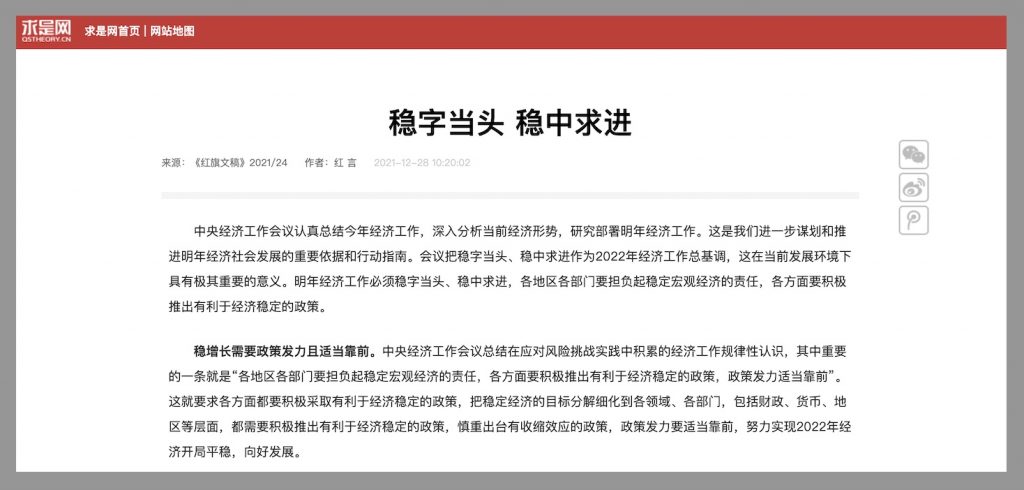Image by Graeme Maclean available at Flickr.com under CC license.
During the fifth session of the 13th National People’s Congress (NPC) in March 2022, one key phrase used to discuss economic development was “Seeking Progress in Stability,” or wenzhong qiujin (稳中求进). In an interview released by the Ministry of Finance during the NPC, the ministry’s top official, Liu Kun (刘昆), used the phrase as he emphasized stability as the core of economic policy:
The general requirement is to take the lead in stability and seek progress in stability, the focus is to increase hedges, and to raise effectiveness, and the main footing is to maintain the macro economy. This policy arrangement balances strength and pacing, the current and the long-term, development and security.
During the conference, the goal of GDP growth of 2022 was set at 5.5 percent, seen as a conservative strategy given the potential impact on China’s economy of geopolitical factors such as tense US-China relations and the war in Ukraine.
In fact, the overarching note (总基调) of “seeking progress in stability” had been struck already in December 2021 at the Central Economic Work Conference in December 2021, the Chinese Communist Party’s chief event to map out economic priorities for the coming year. While the emphasis was on maintaining “high-quality development” (高质量发展), “stability” was the concept that all Party and government officials were told to keep foremost in their minds as they promoted “economic work” in 2022. As the People’s Daily summarized the conference, there were three lines of “stability” to be maintained for 2022. “The 20th National Congress of the CCP will be held next year, a major event in the political life of the Party and the country,” the paper said, “and we must maintain a stable and healthy economic environment, a social environment of national peace and security, and a clean and upright political environment.”

While the emphasis on “seeking progress in stability” can be said to respond to continuing global uncertainties, such as the tense US-China relationship, as well as domestic concerns such as the continued spread of COVID-19, the phrase has in fact been used by the CCP for at least 20 years. In the decade since 2011, the phrase has been a constant feature of CCP discourse about the economic, and political, outlook for the country.
The ‘90s
Usage of the phrase in the 1990s reveals how it generally appears in times of economic and/or political difficulty, when the impetus to move forward for either the economy or a particular segment of the economy is constrained by certain risk factors.
The first headline appearance of the phrase “seeking progress in stability” in the People’s Daily was on April 3, 1991, as China was in the midst of what scholar David Shambaugh called a “siege mentality,” a “year of caution in China” following still in the wake of the crackdown on pro-democracy movement in June 1989. This was a time of tensions between state and society, and a period in which China’s annual rate of economic growth fell by two percentage points. “Seeking progress in stability” was about maintaining social and political stability while still managing to plod forward.
The People’s Daily article, headlined “All of One Mind: Seeking Progress in Stability” (万众一心, 稳中求进), was about that year’s National People’s Congress (NPC), during which “the reporter listened in on . . . . delegation meetings, read the ‘two sessions’ briefing,’ and spoke with delegates,” coming to the conclusion that there had been consensus on the “momentum of seeking progress in stability.”
In the late 1990s, as restructuring was the order of the day at state-owned enterprises and the economy underwent major change, this had a huge impact on previous stars such as China’s township and village enterprises (乡镇企业). TVEs, which had thrived through the 1980s, were progressively dismantled through 1996. The People’s Daily carried a story on January 17, 1997, called “Another year of Seeking Progress in Stability – A Look Back at the Economic Operation of TVEs in 1996.”

In other words, things were getting tougher for TVEs, but development should proceed with cautious optimism.
Use of “seeking progress in stability” was more concentrated in 1997 and 1998, following a rougher year in 1996 marked by fears over inflation and talk of a possible “hard landing” for the economy. The mood at the NPC in 1997 was warily positive. A headline in the People’s Daily on March 6, 1997, read: “Seeking Progress in Stability: The Economic Main Theme for 1997” (稳中求进: 九七经济主旋律).
2011 and Onward
2011 and 2012 brought another upsurge in use of “seeking progress in stability,” stemming from the August 8, 2011, crash of US and global stock markets, and from fears of an economic slowdown in China. Introduced at the Central Economic Work Conference in December 2011, the phrase consolidated the sense that China would need to proceed cautiously given the rising complexity of the global situation. There was also a growing sense of the need for China to transition its economy to create greater domestic consumption and reduce dependency on volatile foreign markets. A report in the People’s Daily on December 15, 2011, shortly after the conference, was called “Seeking Progress in Stability: Growing Domestic Demand” (稳中求进, 扩大内需). One passage read:
Since this year, world economic growth has slowed down, the growth rate of international trade has fallen back, the international financial markets have been violently turbulent, so that various risks have significantly increased. Looking ahead to next year, the world economic situation in general will remain very serious and complex, and [overall] the instability and uncertainty of the world economic recovery has increased. Therefore, the Central Economic Work Conference clearly put forward ‘seeking progress in stability’ as the general tone of economic work for the next year.
Much of the language concerning “seeking progress in stability” coming out of the 2021 Central Economic Work Conference and the 2022 NPC is virtually identical to the language used in 2011. It is even possible now to say that the past 10 years has been decade of “seeking progress in stability.” Headwinds, tensions and pressures have been a constant concern for the CCP when it comes to economic planning, and the related and all-important question of political and regime security.

Stella Chen
The CMP Dictionary
C
D
F
G
M
N
P
S
- Scaling the Wall
- Science
- Second-Generation Reds
- Security
- Seeking Progress in Stability
- Seeking Truth From Facts
- Self-Revolution
- Seven Bottom Lines
- Six Adheres
- Smart Governance
- Sneaky Visit
- So-Called
- Socialite
- Soft Resistance
- Soul and Root
- Soundless Saturation / Quietly Nourishing
- Sovereignty
- Speaking Politics
- Streamlining Services
- Strong Cyber Power

